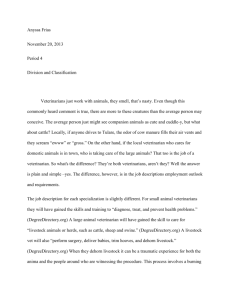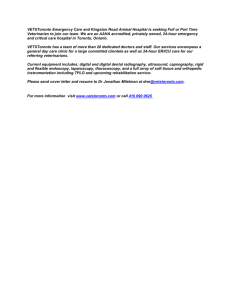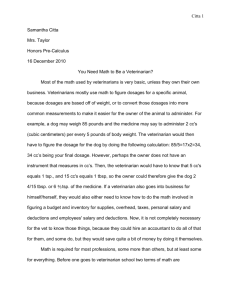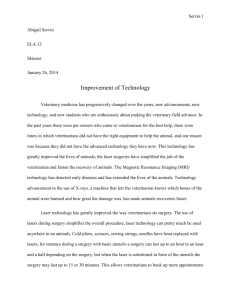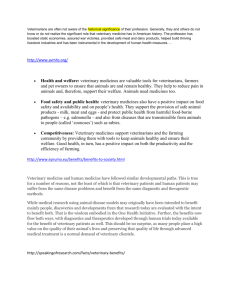Example Research Paper
advertisement
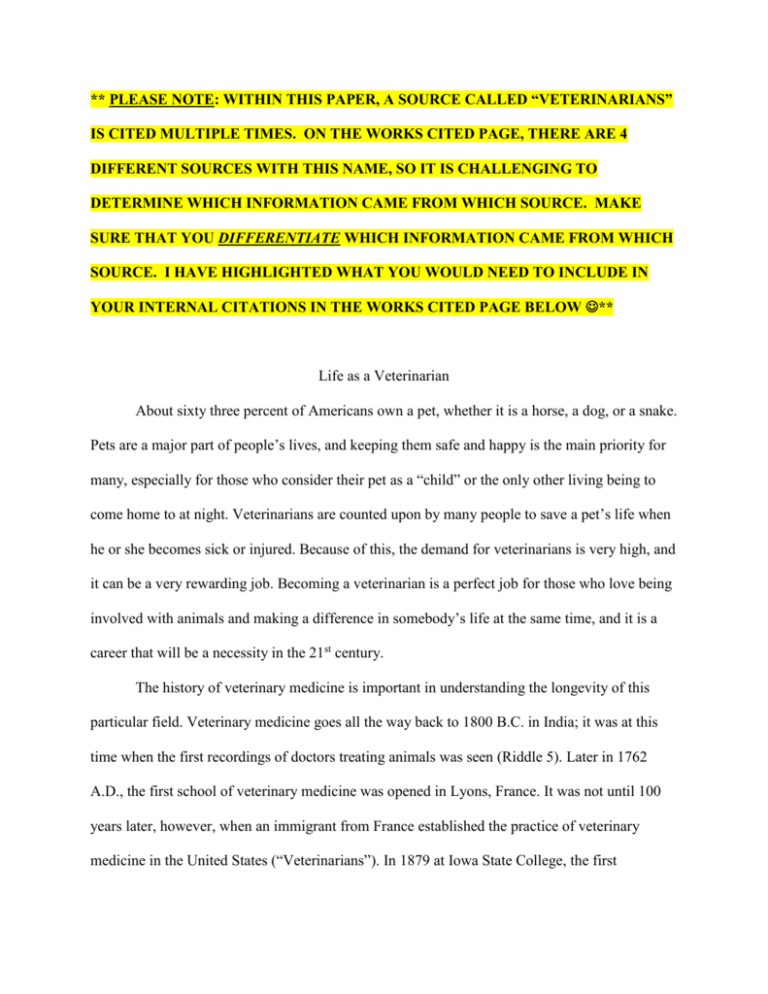
** PLEASE NOTE: WITHIN THIS PAPER, A SOURCE CALLED “VETERINARIANS” IS CITED MULTIPLE TIMES. ON THE WORKS CITED PAGE, THERE ARE 4 DIFFERENT SOURCES WITH THIS NAME, SO IT IS CHALLENGING TO DETERMINE WHICH INFORMATION CAME FROM WHICH SOURCE. MAKE SURE THAT YOU DIFFERENTIATE WHICH INFORMATION CAME FROM WHICH SOURCE. I HAVE HIGHLIGHTED WHAT YOU WOULD NEED TO INCLUDE IN YOUR INTERNAL CITATIONS IN THE WORKS CITED PAGE BELOW ** Life as a Veterinarian About sixty three percent of Americans own a pet, whether it is a horse, a dog, or a snake. Pets are a major part of people’s lives, and keeping them safe and happy is the main priority for many, especially for those who consider their pet as a “child” or the only other living being to come home to at night. Veterinarians are counted upon by many people to save a pet’s life when he or she becomes sick or injured. Because of this, the demand for veterinarians is very high, and it can be a very rewarding job. Becoming a veterinarian is a perfect job for those who love being involved with animals and making a difference in somebody’s life at the same time, and it is a career that will be a necessity in the 21st century. The history of veterinary medicine is important in understanding the longevity of this particular field. Veterinary medicine goes all the way back to 1800 B.C. in India; it was at this time when the first recordings of doctors treating animals was seen (Riddle 5). Later in 1762 A.D., the first school of veterinary medicine was opened in Lyons, France. It was not until 100 years later, however, when an immigrant from France established the practice of veterinary medicine in the United States (“Veterinarians”). In 1879 at Iowa State College, the first veterinary school of medicine was established in the United States (Riddle 5). Along with Iowa State, there are now 28 schools of veterinary medicine in the United States. There are many different fields within the practice of veterinary medicine. Veterinarians can limit their practice to one group of animals, such as aquatic animals or wildlife. A small animal veterinarian is the most pursued field and more than half of the veterinarians today limit their practice to this field (“Veterinarians”). There are many courses that can be taken in college to coordinate with this specific field, but most courses are restricted to domestic land animals, such as farm animals or house pets (Are You). Small animal veterinarians are probably the image that comes to mind when thinking about the veterinary profession. They work in an office all day and care for companion animals such as dogs, rabbits, reptiles, or any other house pet. A small animal veterinarian can perform many different tasks during the day. These tasks include the following: diagnose health problems, give vaccinations, medicate animals against sickness or infection, perform surgery, treat wounds, set fractures, advise animal owners, and euthanize animals when necessary (McKay). Large animal veterinarians are not as common as small animal veterinarians, but there is a high demand for them. This type of veterinarian is for people who love being outdoors and do not mind getting a little bit dirty. A large animal veterinarian will mostly work with farm animals, such as cattle, sheep, and pigs; additionally, they may be asked to work with carnival or circus animals if they are in the area (Moore). Large animal veterinarians do not spend much time inside, but a typical day will start with appointments at the clinic and then they will travel to different areas for work (Moore). Daily work typically involves vaccinating livestock, but these veterinarians may also have to help with births, treat wounds or illnesses, or diagnose diseases. Typical hours per week range from 50 to 60, but when first starting out it could be more like 100 (Moore). Large animal veterinarians not only practice privately but some work for universities, zoos, theme parks, and meat-producing companies (Moore). These companies use foodproducing animals, such as chickens and cows, to make meat products. If these animals are not healthy, then the food will be bad and people will get sick, which is bad for business. Large animal veterinarians treat these animals, so if there is a decrease in these vets then there could be a decrease in food supply (Moore). Large animal veterinarians are very important to society and can change the way humans live. Good candidates for becoming a large animal veterinarian should be good at science and should be passionate about animals. They also need to be physically fit, comfortable with the outdoors, and fearless around large animals that may overpower them (Moore). Along with specifying in a group of animals, veterinarians can specialize in one area of medicine, just like doctors. Specialty veterinarians have a very good job outlook, mostly in metropolitan areas with an abundance of pet owners (“Veterinarians”). Some fields include cardiology, ophthalmology, radiology, dentistry, surgeon, Emergency Room specialist, orthopedics, and many others. Animals need almost exactly the same basic care that a human needs, so any specific doctor there is for a human there is one for an animal, too. Character is a vital part in the job of being a veterinarian. Many different character traits are needed in order to perform this job successfully, but there are a few that are the most important. The first one is ethics, which involves making ethical decisions in tough situations. People with ethics value integrity and trustworthiness, tell the truth, and do not withhold information, even if the information is something that will be hard to say or difficult to accept (Riddle 19). Additionally, they will always keep their promises, even if it gets hard, and will never betray anyone (Riddle 19). Additional character traits that are important are respect and compassion. Valuing respect and compassion involves being polite and courteous to all, especially those who are rude, accepting others who are different, assisting the mistreated, and sharing (Riddle 27). A respectful and compassionate veterinarian will also share information, consider other people’s perspectives, and treat others as they wish to be treated (Riddle 27). Finally justice and fairness are two more character traits. Being just and fair consists of treating everybody the same, being open-minded and willing to listen to others, considering all options before making a decision, and never taking advantage of others (Riddle 36). Furthermore, a just and fair person will cooperate and recognize uniqueness (Riddle 36). As far as work ethic is concerned, self-discipline and diligence are two of the most important characteristics. Loving animals is never enough because there is a lot of hard work that is involved. Emotions, actions, and impulses must always be controlled along with giving the best help at all times, even when it gets hard (Riddle 62). Patience is greatly required along with determination and the will to succeed all the time (Riddle 62). Responsibility is one of the last most important attributes needed in order to practice veterinary medicine. Being responsible during the job involves thinking before acting, not blaming others, being dependable, and not making excuses (Riddle 47). The animal depends on a veterinarian for their life, and the vet is responsible for the animal’s health. Not only is there a responsibility to the animal’s health but there is a responsibility to the humans. People count on a veterinarian to care for their animal that they love so much and do not want to see suffer. The education received and activities done throughout high school can affect a person’s veterinary career in the long run. Applicants into medical college and veterinary school should have a strong background and interest in science, biology, and math. Additional courses taken in high school that focus on these areas will increase the chance of being accepted (Are You). Not only will colleges look at grades but they will also look at experience around animals (Are You). Martin Goldberg, a veterinarian in Georgia, suggests working for the local vet, volunteering at an animal shelter, or working on a farm; any hands-on experience is beneficial (Bart). Communication and writing courses should also be taken because communicating with people is the main part of the job, since animals cannot talk for themselves (Bart). A veterinarian is a well-educated individual. It takes four years of undergraduate college and then veterinary college to become a veterinarian. Those applying to veterinary school should have a grade point average of 3.0 or higher and at least B grades (Riddle 9; “Veterinarians”). Competition is very high, and for every person who is accepted, five are not, and fewer than half of those who apply are accepted (Bart; “Veterinarians”). A master’s degree is not required for acceptance, but the odds of being accepted will increase with this level of degree (McKay). Sixty percent of attendees at veterinary school are women, and the Doctor of Veterinary Medicine degree, also known as DVM or VMD, is earned after graduating from veterinary college (Riddle 8; McKay). When applying, results from the Graduate Record Examination (GRE), Veterinary College Admission Test (VCAT) or Medical College Admission Test (MCAT) must be submitted (Riddle 9). Veterinary school is statistically harder to get into than medical school, so applicants need to have very competitive grades and a desire to work hard. Even after graduating college, education must be continued in order to keep up with new skills and techniques (Are You). This helps the veterinarian maintain knowledge on new technologies, recent diseases, and new ideas that are introduced (Are You). Some veterinarians subscribe to journals along with taking classes, which helps them to further increase their knowledge of practicing veterinary medicine (Are You). Once graduated from veterinary school, individual practicing can begin; however, a licensing exam must be taken first. An exam must be taken for each state that the vet would want to practice in, and this exam is called the North American Veterinary Licensing Exam, or NAVLE (Riddle 12). After prospective veterinarians pass the exam, an oath must be taken to ensure that the skills learned will be used in the best way possible every day (Are You). Most graduates start as employees in somebody else’s practice before opening their own in order to gain more experience (McKay). Sixty-six percent of veterinarians are in private clinical practice and there are 86,000 veterinarians today (Are You). The job outlook is very promising for those pursuing a veterinary career and those already in the career. Those who work in feline medicine are expected to have a very high increase in demand due to the fact that the cat population is growing rapidly (Riddle 77). Support for public health and food safety, international and national disease control, and biomedical research on human health problems will also contribute to the increase in demand for veterinarians (Riddle 81). Since becoming a veterinarian does not require a master’s degree the job is predicted to experience faster growth than other jobs that do (McKay). Veterinarians may be self-employed, or the city, state, county and government can employ them (“Veterinarians”). Those with training in public health and epidemiology have the best career opportunities within the federal government (Riddle 83). Veterinarians can work with physicians to help prevent and detect human health problems such as AIDS or cancer (Riddle 81). Daily work and responsibilities will vary within each field (Are You). The average salary is $79,000 for a privately practicing veterinarian, but this varies from job-to-job and person-to-person (Are You). The salary level within this position should not influence one’s decision to go into this profession; any career should be sought after because it is in the person’s heart, and they love it. Veterinarians make an important contribution to society. People count on vets to take care of the pets that they love and adore. Without pets and vets, human life would be completely different. An animal’s life would be shorter, and a human’s life would not be as full. All of the hard work that goes into becoming a veterinarian and completing the job daily is what really pays off in the end. Our modern world is certainly changing rapidly with technological advancements, such as more sophisticated communication systems and robotic replacements within the workplace; however, a well-trained and educated veterinarian can never be replaced. This will be a valuable career well into the 21st century and beyond. Works Cited "Are You Thinking about Becoming a Veterinarian?" Ask a Veterinarian Online Questions about Pet Health Care. Web. 03 Feb. 2011. Bart, Russell. "Veterinarian." Scholastic Choices 19.3 (2003): 24. MAS Ultra - School Edition. EBSCO. Web. 4 Feb. 2011. McKay, Dawn Rosenberg. "Veterinarian - Career Brief." Career Planning - Career Planning Guide. Web. 03 Feb. 2011. Moore, Carole. "Caring for the Big Guys." Career World 37.3 (2008): 8. MAS Ultra - School Edition. EBSCO. Web. 3 Feb. 2011. Riddle, John, and Rae Simons. Careers with Character: Veterinarian. Broomall, PA: Mason Crest, 2003. Print. Roane, John. AAVMC: The Future of Veterinary Medicine. Web. 05 Feb. 2011. "Veterinarians." Careers and Career Information - CareerOneStop. Web. 03 Feb. 2011. "Veterinarians." Careers In Focus. 3rd ed. New York: Ferguson, 2006. 141-48. Print. "Veterinarians-MyFuture." MyFuture.com - Figure Out What's Next. Web. 05 Feb. 2011. "Veterinarians: Training, Salary, & Career Information." CollegeGrad.com. Web. 05 Feb. 2011.
